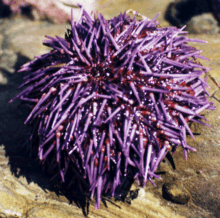
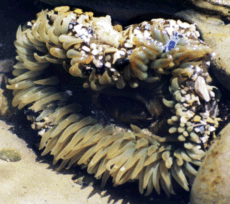
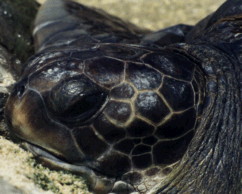
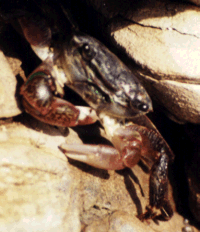
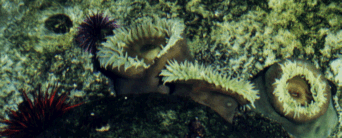
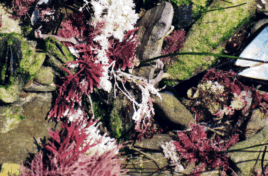
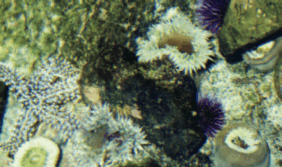
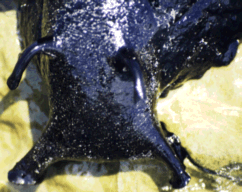

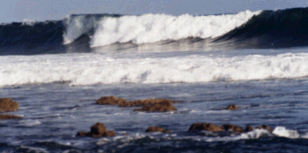
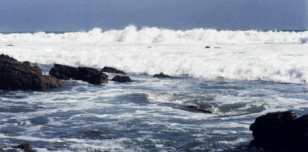
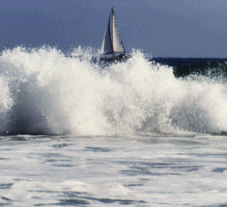
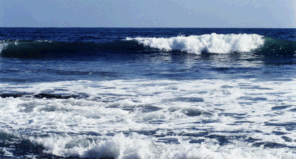
INNER TIDAL POOL |
This is an inner tidal pool. Inner because it extends out from a land shore, as opposed to a tide pool off shore. |
Inner tidal pools are formed along shore-lines which are bordered by steep rocky cliffs rather than wide sandy beaches. |
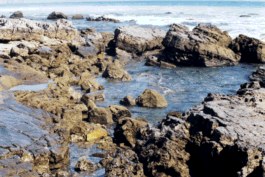
Sandy beaches are made up of mostly crushed shells. All of the brown rocks in the inner tidal pools are also made up of mostly crushed shells. |
As the moon moves across the sky, it causes the ocean to swell two times a day, and reduce two times a day {roughly every six hours}. This is caused by the fluctuation of the gravitational pull. It works kind of like two magnets when you try to put them together. One way they stick to each other, the other way it is just the oppisite they push away from each other. |
When the ocean swells, it draws toward the center of itself, and away from land. This would be low tide. When the swell reduces, the force of the mass weight of water pushing back down on itsself causes a great ripplng affect. The large ripples (swells) roll toward land building momentum along the way. When a swell reaches shallow water there is no longer the depth required to maintain momentum it begins to roll over the top of itself. This is a wave. Some large waves do form for other reasons such as storms. |
As the wave rolls toward the shore it churns up the bottom like the roller on the bottom of a vacuum cleaner. Empty shells are the lightest items on the bottom so they get swept right along. The shells are trapped in a horizonal blender, so to speak. Two things happen to them; They get broken into pieces, and all of the pieces land on the beach with smooth edges and surfaces, The older the shell the tougher it is to break-up. |
When a wave hits a wide fairly level shore it quickly runs out of steam as the force of the water spreads out over the land. The pieces of shell are spread out like a blanket layer upon layer ever slowly grinding into sand. |
When a wave hits a shore, and is confronted by a sheer rock wall the impact is great. Often pieces of the rock wall give way to the force. It is no slow process, it's just "Bam" and down comes a large chunk. Every year sections of the pacific coast highway (PCH) give way to the great land grabber. So, when all of the shells, churned up and broken, hit the wall the pressure put upon them is unimaginable. Ocean water evaporates quickly and leaves a sticky film which if not rinsed off begins to build layers. Small particles of shell dust stick to it, and then become sticky themselves. Now bigger pieces of shell can stick, and so it goes until you have the rocks that make up the inner tidal pools. Because the rocks are made up of bits and pieces they are full of cracks, holes and crevises which make perfect homes for the creatures that you are seeing on this page. They also make for sharp edges on your hands and feet.The creatures that live here seem so small and fragile, yet they live in some of the most ferocious conditions in existence. In fact these areas can be dangerous for people. It takes a while to get to an inner tidal pool, because of having to go around the cliff. If you stay to long the next thing you will know, will be the fourteen foot waves sandwiching you against the rocks. |
As the rocks form, grow, and break apart they look like separate rocks spread out across the water. However what you see is only the peaks sticking out from a whole giant floor of the shell rock material. When you look at the picture on the top of the page try to imagine that it really is one giant rock, all one single piece nearly a mile long, and just as wide. When the tide is out you can walk all over the area. Their is one problem, every single square inch of it is alive and moving. |
Boaters who do not read charts, or are not aleart, could happen upon one of these areas not knowing that there are hard jagged rocks lurking just below the surface of the water, waiting for a swell to drop a boat right on them. It happens more often than one might think. |
This is a sea anemone. It feels very sticky. You can see all of the pebbles and shell fragments stuck to it, and it seems to be suctioned or glued to its spot. It actually has tens of thousands of nearly microscopic hairs that work like velcro, only able to latch on to anything. Living microorganisms that are its food source are constantly stirred up by the water. All it has to do is sit and wait for a meal to come sticking by. |
This is group of them, as you can see they can shape shift. |
The tide is washing in. Under all of the white foam you see in the picture is the rock floor. The foam is caused by the water sifting so rapidly through all of the air pockets in the rocks. |
The purple sea urchin. This spiny creature feeds much the same way as the anemone. His spines are sticky at the base, and he can spread them out by flexing its skin muscle into a more "spiked do." As a cloud of its favorite microbs float by it lets down its hair and traps thousands of tiny morsels for lunch. |
This blue belly desert lizard shows up every where. His blue belly is highly reflective and heat resistant. The tide moves out leaving behind stranded creatures which quickly rot in the sun. They become food for the birds, and draw plenty of bugs for this guy, who knows just when to show up for a meal. |
This is a, sea slug / sea snail / sea cucumber. It can roll up into a cylinder with rounded ends, and it has bumps just like a cucumber. It likes plant life for its meals. It just sucks on to a piece, and desolves it with special saliva just like a snail. It also slithers along like a snail. |
These are coral fern plants. Coral because of their color. Fern because of their shape and texture. They do not get hard like most coral. |
This sea turtle is an occasional visitor, dropping in for a snack. |
Well the tide is all in and the rocks are all covered waiting for some unsuspecting boater. Yes believe it or not this is a photograph of the same place, taken from the same spot. When the tide goes back out it will leave wading pools all over the rock floor |

This is a spotted rock crab. It is about the size of a silver dollar. |
Back to home page. |
To previous page. |
Close this window if you came from the photos page |



